|
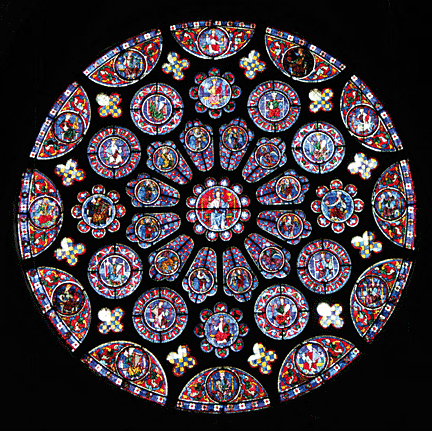 Stained
glass has fascinated people for centuries. Its beginnings can be traced back
to the Church of St. Paul, near Rome, built by Constantine in 337 A.D, in
which mosaic windows were held in place by metal frames or pierced stone
slabs. Painted glass windows, however, date from about the time of
Charlemagne, 800 A.D. Stained
glass has fascinated people for centuries. Its beginnings can be traced back
to the Church of St. Paul, near Rome, built by Constantine in 337 A.D, in
which mosaic windows were held in place by metal frames or pierced stone
slabs. Painted glass windows, however, date from about the time of
Charlemagne, 800 A.D.
The Origins of Stained Glass
Early in the 12th century, the monk Theophilus first recorded an ancient
glass-making formula which when heated turned a pale green color. As the
craftsman applied more heat, the mixture turned a warm purple.
Later, they colored glass by adding metallic oxides and salts to the molten
ash-and-sand mixture during the process of fusion. Different temperatures
produced different colors. In the beginning, the colors were limited to red,
blue, purple, green and yellow. They created red, the most difficult to
produce, by throwing copper filings and flakes of iron into the molten
mixture. For rich, azure blues, they used cobalt oxides. Copper dioxide
produced green, manganese oxide purple, and dioxide of manganese yellow.
 The
term “stained glass” refers to the basic coloring of molten glass, the point
at which color becomes fused with clear glass. It came into use at the
beginning of the 19th century as a contraction of "painted and stained
glass." In the Middle Ages, it was simply called "glass" or glaziers' work."
Gathering the molten glass on the end of his blowing tube, the glass bowler
blew the liquid into a rough sphere, and, by swinging and twisting, obtained
a cylindrical shape. This was cut at both ends, opened along its axis, and
allowed to cool. It was then placed in an annealing oven and reheated,
causing the glass to flatten out on a stone, forming a small sheet of uneven
thickness. Made in this way, medieval glass—like today's "antique glass"—had
considerable variations of thickness, causing greater and lesser intensities
of color within each sheet. This harmonious union of flaws and
irregularities, reams and air bubbles, caused the glass to refract the sun's
rays, making the now-colored light dance and sparkle. The
term “stained glass” refers to the basic coloring of molten glass, the point
at which color becomes fused with clear glass. It came into use at the
beginning of the 19th century as a contraction of "painted and stained
glass." In the Middle Ages, it was simply called "glass" or glaziers' work."
Gathering the molten glass on the end of his blowing tube, the glass bowler
blew the liquid into a rough sphere, and, by swinging and twisting, obtained
a cylindrical shape. This was cut at both ends, opened along its axis, and
allowed to cool. It was then placed in an annealing oven and reheated,
causing the glass to flatten out on a stone, forming a small sheet of uneven
thickness. Made in this way, medieval glass—like today's "antique glass"—had
considerable variations of thickness, causing greater and lesser intensities
of color within each sheet. This harmonious union of flaws and
irregularities, reams and air bubbles, caused the glass to refract the sun's
rays, making the now-colored light dance and sparkle.
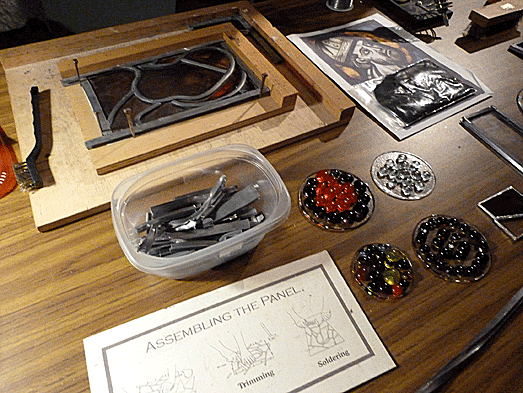 After
being cut, each glass piece was placed in position and inserted into its
lead channel and soldered at the joints until a panel of predetermined size
could be lifted in one piece. A putty-like compound was then hand-rubbed
into the areas between the lead flanges and the surface of the glass, making
it weatherproof and providing additional strength as well. The completed
windows were made up of a number of panels set between iron crossbars,
additionally supported with tied and soldered small square rods fashioned by
a blacksmith. After
being cut, each glass piece was placed in position and inserted into its
lead channel and soldered at the joints until a panel of predetermined size
could be lifted in one piece. A putty-like compound was then hand-rubbed
into the areas between the lead flanges and the surface of the glass, making
it weatherproof and providing additional strength as well. The completed
windows were made up of a number of panels set between iron crossbars,
additionally supported with tied and soldered small square rods fashioned by
a blacksmith.
Types of Stained Glass
There are almost as many different styles of stained glass windows as there
are windows, themselves. The 13th century, the age of "cathedral glory," saw
windows that had a shimmering, ethereal quality, as if matter had
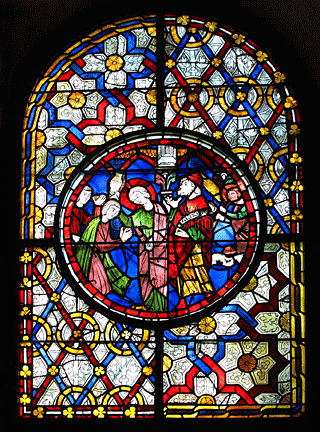 been
transformed. Negative space, in the form of paint and lead, allowed some
colors to merge harmoniously, while others seemed to dance and vibrate with
the movement of the sun. As evening approached, the iridescent jewels of
color began to dull, receding into an atmosphere of peace and tranquility.
Grisalle and semi-grisalle windows--those with a light monochromatic color
scheme--were used frequently in churches toward the end of the 13th century,
probably due to a demand for increased interior light. been
transformed. Negative space, in the form of paint and lead, allowed some
colors to merge harmoniously, while others seemed to dance and vibrate with
the movement of the sun. As evening approached, the iridescent jewels of
color began to dull, receding into an atmosphere of peace and tranquility.
Grisalle and semi-grisalle windows--those with a light monochromatic color
scheme--were used frequently in churches toward the end of the 13th century,
probably due to a demand for increased interior light.
It's sometimes supposed that enamel painting on stained glass is a
relatively late
innovation. While it was possible to make a patterned or pictorial window
entirely of glass and lead work, such windows weren't produced until after
the end of the Middle Ages. In a good stained glass window, the lead work
isn't only a container for the glass but also an integral part of the
design, but the details of a picture, such as the features of faces, folds
of drapery or petals of a rosette were from the earliest times done by
painting with a brush dipped in black enamel pigment derived from iron.
The Revival of a Lost Art
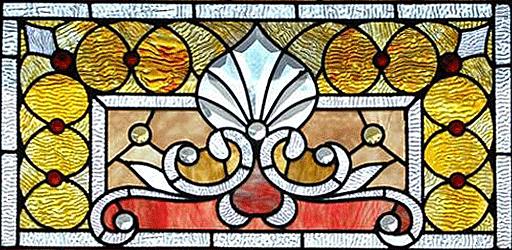 The
old techniques were all but obliterated during the 17th and 18th centuries,
becoming a lost art. With the Gothic Revival Period of Victorian times came
a call for pure color in glass once again. But now designers no longer
created windows just for churches. The glazier again became as important as
the glass painter, and lead once more became an integral part of window
design. The
old techniques were all but obliterated during the 17th and 18th centuries,
becoming a lost art. With the Gothic Revival Period of Victorian times came
a call for pure color in glass once again. But now designers no longer
created windows just for churches. The glazier again became as important as
the glass painter, and lead once more became an integral part of window
design.
Stained glass is to this day often the production of virtually unnamed
artists. Later 19th-century glaziers all signed their work. Sometimes these
"signatures" were merely symbols, such as a monk in a habit as a sign of the
Powell family of
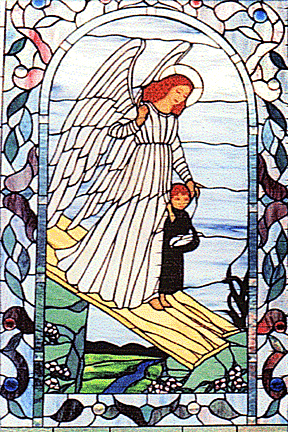 Whitefriars,
England. Some hid their initials somewhere in the glass design. The
signature, if there is one, should be authenticated, according to said
Michael Delaware, president of Artistic Glass of Roswell (Atlanta), Ga. Whitefriars,
England. Some hid their initials somewhere in the glass design. The
signature, if there is one, should be authenticated, according to said
Michael Delaware, president of Artistic Glass of Roswell (Atlanta), Ga.
Of all the stained glass designers, Tiffany is probably the most well known
to Americans. “Though he pioneered in stained glass windows in America at
the turn of the century, he, himself, never personally made any of his
windows," said Delaware.
Later, as World War I took its toll on the world's economy, Frank Lloyd
Wright embraced the Art Deco style for his window designs, helping to
further the interest in non-religious stained glass.
Collecting Stained Glass
But not everyone can collect large windows. For one thing, they can't be
hung like a painting. Most need to be mounted permanently. Though larger
ones sell from $5,000 to $50,000, smaller, more common window designs are
available from $200-300, according to Jeff Venturella, owner of the
Architectural Emporium in Pittsburgh, Pennsylvania. "We've got plenty of
transoms in their original frames. Many people hang these in front of their
regular windows. I suggest this because if they're built in, they can't take
them with them if they sell their house."
 While
the best examples of medieval stained glass are in the great cathedrals of
France at Chartres and in Paris at Saint Chappelle and others, there are
extraordinary examples here in the United States in historic Bryn Athyn, a
small town just outside of Philadelphia that’s home to the New Church and
Bryn Athyn Cathedral. Glaziers from all over Europe produced all the windows
in this church on site in much the same manner as those in Europe’s greatest
cathedrals. Though the designs are distinctly representative of the
teachings of the New Church, the techniques and colors harken back to
medieval times. While
the best examples of medieval stained glass are in the great cathedrals of
France at Chartres and in Paris at Saint Chappelle and others, there are
extraordinary examples here in the United States in historic Bryn Athyn, a
small town just outside of Philadelphia that’s home to the New Church and
Bryn Athyn Cathedral. Glaziers from all over Europe produced all the windows
in this church on site in much the same manner as those in Europe’s greatest
cathedrals. Though the designs are distinctly representative of the
teachings of the New Church, the techniques and colors harken back to
medieval times.
There's only one major stained glass museum in the world--The Stained Glass
Museum of Ely Cathedral, in Ely, England. It displays over 100 panels,
tracing the history of the craft from medieval to modern times, at eye-level
so that they can be viewed closely.
<
Back to
Antiques Articles
Go to the next antiques article >
|
